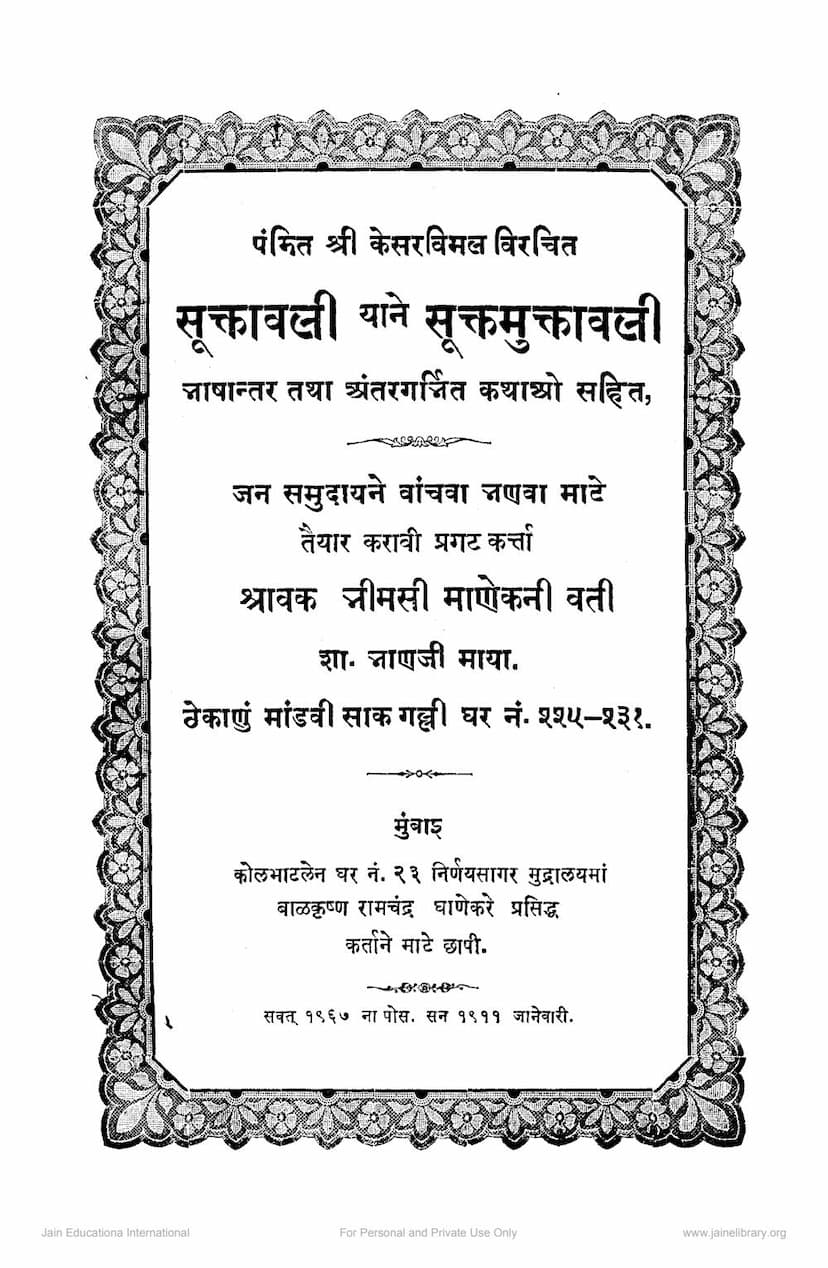Suktavali Yane Suktmuktavali
Added to library: September 2, 2025

Summary
Here's a comprehensive summary of the Jain text "Suktavali yane Suktmuktavali" by Shravak Bhimsinh Manek, based on the provided pages:
Book Title: Suktavali yane Suktmuktavali Author: Shravak Bhimsinh Manek (Compiler/Publisher), Original work by Pandit Shri Kesar Vimal Publisher: Shravak Bhimsinh Manek Catalog Link: https://jainqq.org/explore/003685/1
Overall Purpose and Structure:
"Suktavali yane Suktmuktavali" (meaning "Collection of Good Sayings" or "Garland of Good Sayings") is a Jain text compiled and published by Shravak Bhimsinh Manek, based on the original work of Pandit Shri Kesar Vimal. The book's primary aim is to guide individuals towards a meaningful human life and ultimately to liberation (moksha) according to Jain principles. It achieves this by presenting wise sayings, philosophical insights, and moral teachings through illustrative stories and narratives.
The text is structured into four main sections or "Vargas" (classes):
- Dharma Varga (Section on Righteousness/Duty): This section focuses on the foundational principles of Jainism, covering topics such as the nature of the divine (Devatattva), the role of spiritual guides (Gurultattva), the essence of Dharma, the importance of knowledge, the rarity of human birth, virtues like contentment, justice, truthfulness, forgiveness, etc., and the duties of monks (Sadhudharma) and lay followers (Shravakdharma).
- Artha Varga (Section on Wealth/Means): This part deals with the acquisition and proper utilization of wealth. It discusses aspects like wealth management, earning wealth ethically, the dangers of greed and stinginess, the importance of good company, avoiding vices (like gambling, drinking, theft, etc.), and the pursuit of fame and knowledge.
- Kama Varga (Section on Desire/Fulfillment): This section addresses the role of desires, particularly in the context of relationships and family. It explores the qualities and faults of men and women, the significance of a good spouse, and the dynamics within a family, including the roles of parents and children. It also touches upon the challenges posed by worldly desires.
- Moksha Varga (Section on Liberation): This is the ultimate goal. This section delves into the nature of Karma, the importance of forgiveness (Kshama), self-control (Sanyam), the twelve contemplations (Dwadash Bhavna), detachment (Nirveda), and self-realization (Atmabodh). It outlines the path to liberation from the cycle of birth and death.
Key Themes and Content:
- Rarity of Human Birth: A central theme emphasized throughout the Dharma Varga is the extreme difficulty of obtaining a human birth. It is presented as a precious opportunity, a ladder for spiritual progress, and the only path to liberation. Other life forms (celestial, animal, and hellish beings) cannot attain moksha directly.
- The Four Purusharthas: The text implicitly or explicitly covers the four aims of human life as understood in Indian traditions: Dharma (righteousness), Artha (wealth/means), Kama (desire/fulfillment), and Moksha (liberation). The book shows how these are interconnected and how pursuing them in the correct order, guided by Dharma, leads to ultimate well-being.
- Importance of Righteous Conduct: The Dharma Varga is extensive, detailing numerous virtues and ethical principles. It highlights the significance of faith in the Tirthankaras (pure divine beings), following the teachings of enlightened gurus, practicing charity, controlling anger, cultivating compassion, maintaining contentment, avoiding pride and deceit, and adhering to righteous principles.
- Ethical Wealth Management: The Artha Varga stresses that wealth is a tool, not an end in itself. It should be acquired through honest means and used for virtuous purposes, including supporting spiritual endeavors and helping the needy. Greed and attachment to wealth are depicted as detrimental.
- Navigating Desires: The Kama Varga addresses the realities of worldly desires and relationships. It serves as a guide to understanding and managing these aspects of life in a way that does not hinder spiritual progress.
- The Path to Liberation: The Moksha Varga provides the core teachings on how to break free from the cycle of rebirth. This involves understanding the workings of karma, cultivating virtues like forgiveness and self-control, meditating on impermanence and the true nature of reality, and ultimately striving for self-realization.
- Illustrative Stories (Prabandhas): The book is rich with narratives that exemplify the principles discussed. These stories feature various figures from Jain lore, including kings, sages, disciples, and even celestial beings, showcasing the consequences of virtuous and unvirtuous actions. Famous examples mentioned include Nami and Vinami, Keshi Kumar and King Pradeshi, Vikram, Shalivahan, Nandi Khesh Muní, Mahavir Swami and Chand Kausik, Rathanemi, Shri Krishna, Sudarshan Sheth and Ajayā Rani, Khandakacharya and his disciples, Dhruvaprahari, and many others. These stories serve as practical lessons for the reader.
- Moral Accountability: The narratives consistently highlight the principle of Karma, where actions have consequences. Individuals who live righteously and cultivate virtues are shown to attain favorable outcomes, while those who indulge in vices and unrighteousness face suffering.
- The Role of Knowledge: The text emphasizes that true understanding comes from knowledge, particularly spiritual knowledge gained through scripture and the guidance of spiritual masters. This knowledge is crucial for discerning right from wrong and for making progress on the spiritual path.
Compilation and Publication:
The text was originally composed in Gujarati by Pandit Shri Kesar Vimal in Vikram Samvat 1754 (around 1797-1798 CE). Shravak Bhimsinh Manek later compiled and published this work with Gujarati translations and elaborations of the stories. The publication date for this specific edition is given as Vikram Samvat 1967 (1911 CE) in January.
In essence, "Suktavali yane Suktmuktavali" is a comprehensive guide that uses a blend of scriptural wisdom, ethical teachings, and engaging narratives to illuminate the Jain path to a virtuous life, spiritual development, and ultimate liberation. It serves as a practical and inspirational resource for individuals seeking to understand and implement Jain philosophy in their lives.